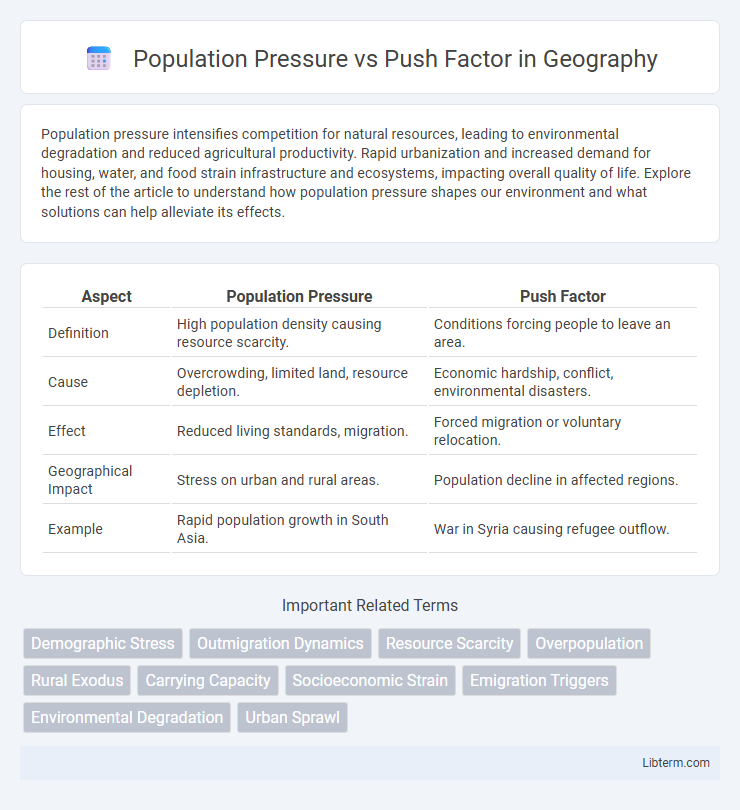Population pressure intensifies competition for natural resources, leading to environmental degradation and reduced agricultural productivity. Rapid urbanization and increased demand for housing, water, and food strain infrastructure and ecosystems, impacting overall quality of life. Explore the rest of the article to understand how population pressure shapes our environment and what solutions can help alleviate its effects.
Table of Comparison
| Aspect | Population Pressure | Push Factor |
|---|---|---|
| Definition | High population density causing resource scarcity. | Conditions forcing people to leave an area. |
| Cause | Overcrowding, limited land, resource depletion. | Economic hardship, conflict, environmental disasters. |
| Effect | Reduced living standards, migration. | Forced migration or voluntary relocation. |
| Geographical Impact | Stress on urban and rural areas. | Population decline in affected regions. |
| Example | Rapid population growth in South Asia. | War in Syria causing refugee outflow. |
Understanding Population Pressure: A Brief Overview
Population pressure refers to the strain exerted on resources and infrastructure due to an increasing population density within a specific area, often leading to food shortages, unemployment, and inadequate housing. This pressure acts as a critical push factor in migration studies, driving individuals to relocate from densely populated regions to less crowded areas or countries in search of better living conditions. Understanding population pressure is essential for policymakers aiming to address socio-economic challenges and design sustainable development strategies.
Defining Push Factors in Human Migration
Push factors in human migration refer to negative conditions or circumstances in an individual's place of origin that compel them to leave, such as unemployment, political instability, natural disasters, and poverty. Population pressure, characterized by high population density and limited resources, often intensifies these push factors by exacerbating resource scarcity, reducing job opportunities, and increasing competition for basic needs. Understanding push factors is essential for analyzing migration patterns as they directly influence the decision to migrate by creating adverse living conditions that drive people away from their homes.
Key Differences Between Population Pressure and Push Factors
Population pressure refers to the strain on resources and living conditions due to a high population density in a specific area, often leading to environmental degradation and limited economic opportunities. Push factors are broader socio-economic or political conditions, such as unemployment, conflict, or lack of services, that drive individuals to migrate from their place of origin. The key difference lies in population pressure being a demographic and environmental concept, while push factors encompass a wider range of motivating reasons behind migration.
How Population Pressure Leads to Migration
Population pressure occurs when the number of people exceeds the carrying capacity of their environment, creating scarcity of resources such as food, water, and housing. This scarcity acts as a push factor, compelling individuals and families to migrate in search of better living conditions and economic opportunities. High population density in rural areas often drives migration toward urban centers or other regions with less strain on resources.
Common Push Factors in Migration Patterns
Common push factors in migration patterns include high population pressure, which strains local resources such as housing, food, and employment opportunities. Environmental degradation, political instability, and lack of access to education and healthcare also contribute significantly to individuals deciding to migrate. Economic hardship driven by unemployment and poor living conditions intensifies the push effect, compelling populations to seek better prospects elsewhere.
Socioeconomic Impacts of Population Pressure
Population pressure intensifies competition for limited resources, leading to unemployment, poverty, and declining living standards. High population density strains infrastructure, education, and healthcare systems, exacerbating socioeconomic inequalities. These conditions act as push factors, compelling migration as individuals seek better economic opportunities and improved quality of life.
Environmental Consequences of Push Factors
High population pressure intensifies resource depletion and environmental degradation, intensifying push factors such as soil erosion, water scarcity, and deforestation. These environmental consequences force communities to migrate due to declining agricultural productivity and increased vulnerability to natural disasters. The interplay between population pressure and environmental push factors creates a cycle of forced displacement and ecosystem stress, exacerbating regional instability.
Case Studies: Population Pressure vs Push Factor
Case studies reveal that population pressure often exacerbates push factors such as unemployment, resource depletion, and inadequate infrastructure, driving migration from rural to urban areas. For example, in Bangladesh, high population density stresses agricultural land, pushing rural inhabitants to seek livelihood opportunities in cities or abroad. Similarly, in sub-Saharan Africa, population growth intensifies land fragmentation and food insecurity, compelling communities to migrate due to the inability to sustain livelihoods.
Policy Responses to Population Pressure and Push Factors
Policy responses to population pressure often include urban planning, investment in infrastructure, and family planning programs to manage resource allocation and reduce migration driven by overcrowding. Addressing push factors such as unemployment, lack of education, and poor healthcare requires targeted economic development, job creation initiatives, and improved social services to stabilize communities and deter outward migration. Integrated approaches combining demographic management and socioeconomic reforms can effectively mitigate population-induced displacement and support sustainable development.
Future Trends in Migration: Balancing Population Pressure and Push Factors
Future trends in migration will be heavily influenced by the interplay between escalating population pressure in densely populated regions and intensifying push factors such as economic instability, climate change, and political unrest. Urban areas facing rapid demographic growth may see increased migration flows as residents seek better opportunities and living conditions elsewhere. Understanding this dynamic balance is crucial for policymakers to develop sustainable migration strategies that address both population saturation and underlying push factors driving migration.
Population Pressure Infographic

 libterm.com
libterm.com